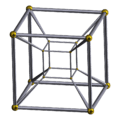Four-dimensional space facts for kids
A four-dimensional space (often called 4D) is a way to think about space that goes beyond the three dimensions we usually experience. In our everyday world, we use three numbers (like length, width, and height) to describe where things are or how big they are. Imagine a box: you measure its length, width, and height to find its size. These are its three dimensions.
The idea of adding a fourth dimension started a long time ago. Thinkers like Jean le Rond d'Alembert in 1754 and Joseph-Louis Lagrange in the mid-1700s began exploring it. The idea became clearer in 1854 with Bernhard Riemann. Later, in 1880, Charles Howard Hinton made these ideas popular. He wrote about a "four-dimensional cube" (called a tesseract) by showing how lines, squares, and cubes build up to higher dimensions.
One way Hinton explained it was by drawing two regular 3D cubes, one inside the other. Then, he connected their matching corners with lines. These connecting lines show a single direction in the "unseen" fourth dimension. You can see this in the animation where a smaller cube is inside a larger one, and lines connect them.
Today, spaces with more than three dimensions are very important in math and physics. For example, Albert Einstein's idea of spacetime uses a 4D space. This space combines our three regular space dimensions with time as the fourth dimension.
Contents
Can Humans See or Understand Four Dimensions?
Even though we live in a 3D world, studies show that humans can actually understand some things about four-dimensional space. Scientists have used virtual reality to test this. They found that people could make good guesses about lines placed in 4D space, even without special training.
Another study tested how well people could find their way through mazes in 2D, 3D, and 4D. The mazes were like simple paths with turns. The people had to navigate and then point back to the start. After some practice, some participants were able to mentally map their path in 4D. This suggests our brains might be able to handle more dimensions than we think!
Four Dimensions in Culture
You might have heard about "dimensions" in Science fiction stories. Often, when sci-fi talks about other dimensions, it means parallel universes or different "planes of existence." The idea is that these other worlds are very close to ours, but the distance to them is in a fourth (or higher) dimension that we can't normally see or travel through.
One of the best-known science fiction books about true geometric dimensions is Flatland by Edwin A. Abbott, written in 1884. It's often suggested as a great way to start thinking about dimensions. The story is about a square who lives in a 2D world and tries to understand a 3D world.
Many early sci-fi stories used the idea of other dimensions. For example:
- In —And He Built a Crooked House (1941) by Robert A. Heinlein, an architect builds a house shaped like a 3D projection of a tesseract.
- Madeleine L'Engle's novel A Wrinkle in Time (1962) uses a fifth dimension to "tesseract" or "fold" space. This allows characters to travel across the universe very quickly.
- The Boy Who Reversed Himself by William Sleator also uses fourth and fifth dimensions in its story.
Four Dimensions in Philosophy
Throughout history, thinkers have wondered about dimensions. For example, in 1783, Immanuel Kant wrote about why space seems to have only three dimensions. He believed this was something we just know intuitively, not something we can prove with concepts alone.
In 1846, a German philosopher named Gustav Fechner wrote a short story called "Space has Four Dimensions." In the story, a shadow person lives on a 2D surface and can only understand two dimensions. Fechner suggested that this shadow person might see the third dimension as time. This story is similar to Plato's famous "Allegory of the Cave" from ancient Greece.
Later, in the early 1900s, some writers explored "hyperspace philosophy." This was a way of using higher dimensions to think about deeper ideas about reality. Charles Howard Hinton, who popularized the tesseract, was one of these thinkers.
Images for kids
See also
 In Spanish: Cuarta dimensión para niños
In Spanish: Cuarta dimensión para niños








